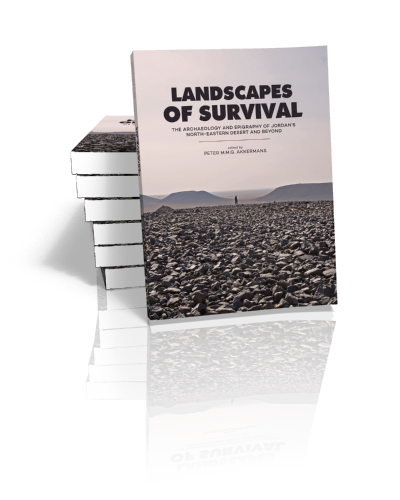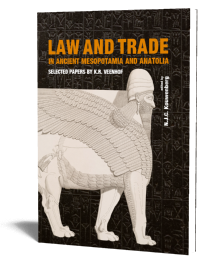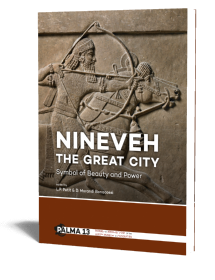Landscapes of Survival
The Archaeology and Epigraphy of Jordan’s North-Eastern Desert and Beyond
Edited by Peter M.M.G. Akkermans | 2020

Landscapes of Survival
The Archaeology and Epigraphy of Jordan’s North-Eastern Desert and Beyond
Edited by Peter M.M.G. Akkermans | 2020
Paperback ISBN: 9789088909429 | Hardback ISBN: 9789088909436 | Imprint: Sidestone Press | Format: 210x280mm | 396 pp. | Language: English | 52 illus. (bw) | 189 illus. (fc) | Keywords: Jordan; desert; mobility; nomads; pastoralists; archaeology; epigraphy; rock art; prehistory; Bronze Age; Iron Age; Roman; Early Islamic; ancient Near East | download cover
Read online or downloaded 711 times
-
Digital & Online access
This is a full Open Access publication, click below to buy in print, browse, or download for free.
-
Buy via Sidestone (EU & UK)
-
Buy via our Distributors (WORLD)
For non-EU or UK destinations you can buy our books via our international distributors. Although prices may vary this will ensure speedy delivery and reduction in shipping costs or import tax. But you can also order with us directly via the module above.
UK international distributor
USA international distributor
-
Bookinfo
Paperback ISBN: 9789088909429 | Hardback ISBN: 9789088909436 | Imprint: Sidestone Press | Format: 210x280mm | 396 pp. | Language: English | 52 illus. (bw) | 189 illus. (fc) | Keywords: Jordan; desert; mobility; nomads; pastoralists; archaeology; epigraphy; rock art; prehistory; Bronze Age; Iron Age; Roman; Early Islamic; ancient Near East | download cover
Read online or downloaded 711 times

We will plant a tree for each order containing a paperback or hardback book via OneTreePlanted.org.
The ‘Black Desert’ begins just south of Damascus and comprises some 40,000 km2 of dark and desolate basalt fields, which stretch from southern Syria across north-eastern Jordan and reach the sand sea of the Nefud in Saudi Arabia. The rough and highly arid terrain is often difficult to access and travel through. Despite these uninviting conditions, recent fieldwork has revealed the immense archaeological and epigraphic record of the Black Desert. This material testifies to the prominent successes achieved by indigenous nomadic peoples in exploiting the basalt range through hunting and herding across centuries and millennia.
To date, there is an ever-increasing interest in the archaeology of the Black Desert. In particular, Jordan is home to a range of international research projects, and exciting new discoveries convincingly demonstrate the archaeological affluence of Jordan’s desert landscape. The present volume provides a wide-ranging and up-to-date examination of the archaeology and epigraphy of the immense basalt expanse as well as comparative perspectives from other parts of the Levant and the Arabian Peninsula. This collection of papers offers detailed insights and analyses on topics ranging from mobility and landscape to developments in settlement and burial practices, as well as the role of rock art and literacy in ancient desert environments. This richly illustrated book is a significant point of reference for what is rapidly becoming a most vibrant and dynamic field of research in the Levant and Arabia.
List of contributors
Foreword
Aktham Oweidi
Introduction: landscapes of survival
Peter M.M.G. Akkermans
First inhabitants: the early prehistory of north-east Jordan
Tobias Richter
New techniques for tracing ephemeral occupation in arid, dynamic environments: case studies from Wadi Faynan and Wadi al-Jilat, Jordan
Daniella Vos
Populating the Black Desert: the Late Neolithic presence
Yorke M. Rowan, Gary O. Rollefson and Alexander Wasse
Flamingos in the desert: how a chance encounter shed light on the ‘Burin Neolithic’ of eastern Jordan
Alexander Wasse, Gary Rollefson and Yorke Rowan
Pastoralists of the southern Nefud desert: inter-regional contact and local identity
Maria Guagnin
The works of the old men in Arabia: a comparative analysis
David Kennedy
Defending the ‘land of the devil’: prehistoric hillforts in the Jawa hinterland
Bernd Müller-Neuhof
The Late Chalcolithic and Early Bronze Age of the badia and beyond: implications of the results of the first season of the Western Harra Survey
Stefan L. Smith
East of Azraq: settlement, burial and chronology from the Chalcolithic to the Bronze Age and Iron Age in the Jebel Qurma region, Black Desert, north-east Jordan
Peter M.M.G. Akkermans and Merel L. Brüning
Identifying nomadic camp sites from the Classical and Late Antique periods in the Jebel Qurma region, north-eastern Jordan
Harmen O. Huigens
The Nabataeans as travellers between the desert and the sown
Will M. Kennedy
The desert and the sown: Safaitic outsiders in Palmyrene territory
Jørgen Christian Meyer
The north-eastern badia in Early Islamic times
Karin Bartl
Depicting the camel: representations of the dromedary camel in the Black Desert rock art of Jordan
Nathalie Ø. Brusgaard
Bows on basalt boulders: weaponry in Safaitic rock art from Jebel Qurma, Black Desert, Jordan
Keshia A.N. Akkermans
‘Your own mark for all time’: on wusūm marking practices in the Near East (c. 1800-1960 AD)
Koen Berghuijs
Rock art in Saudi Arabia: a window into the past? First insights of a comparative study of rock art sites in the Riyadh and Najrān regions
Charly Poliakoff
Graffiti and complexity: ways-of-life and languages in the Hellenistic and Roman harrah
Michael C.A. Macdonald
Gaius the Roman and the Kawnites: inscriptional evidence for Roman auxiliary units raised from the nomads of the harrah
Ahmad Al-Jallad, Zeyad Al-Salameen, Yunus Shdeifat and Rafe Harahsheh
Remarks on some recently published inscriptions from the harrah referring to the Nabataeans and the ‘revolt of Damași’
Jérôme Norris
Two new Safaitic inscriptions and the Arabic and Semitic plural demonstrative base
Philip W. Stokes

Prof. dr. Peter M.M.G. Akkermans
Peter M.M.G. Akkermans is Full Professor of Near Eastern Archaeology at Leiden University, The Netherlands. He studied Prehistory and Archaeology of Western Asia at the University of Amsterdam, where he also completed (cum laude) his PhD on Neolithic settlement in Syria. From 1990 until 2009 he was Curator of the Dept. of the Ancient Near East in the Netherlands National Museum of Antiquities, in combination with an Extraordinary Professorship of Near Eastern Prehistory at Leiden University. Since 2010 Akkermans is Full Professor of Near Eastern Archaeology at Leiden University.
Abstract:
The ‘Black Desert’ begins just south of Damascus and comprises some 40,000 km2 of dark and desolate basalt fields, which stretch from southern Syria across north-eastern Jordan and reach the sand sea of the Nefud in Saudi Arabia. The rough and highly arid terrain is often difficult to access and travel through. Despite these uninviting conditions, recent fieldwork has revealed the immense archaeological and epigraphic record of the Black Desert. This material testifies to the prominent successes achieved by indigenous nomadic peoples in exploiting the basalt range through hunting and herding across centuries and millennia.
To date, there is an ever-increasing interest in the archaeology of the Black Desert. In particular, Jordan is home to a range of international research projects, and exciting new discoveries convincingly demonstrate the archaeological affluence of Jordan’s desert landscape. The present volume provides a wide-ranging and up-to-date examination of the archaeology and epigraphy of the immense basalt expanse as well as comparative perspectives from other parts of the Levant and the Arabian Peninsula. This collection of papers offers detailed insights and analyses on topics ranging from mobility and landscape to developments in settlement and burial practices, as well as the role of rock art and literacy in ancient desert environments. This richly illustrated book is a significant point of reference for what is rapidly becoming a most vibrant and dynamic field of research in the Levant and Arabia.
Contents
List of contributors
Foreword
Aktham Oweidi
Introduction: landscapes of survival
Peter M.M.G. Akkermans
First inhabitants: the early prehistory of north-east Jordan
Tobias Richter
New techniques for tracing ephemeral occupation in arid, dynamic environments: case studies from Wadi Faynan and Wadi al-Jilat, Jordan
Daniella Vos
Populating the Black Desert: the Late Neolithic presence
Yorke M. Rowan, Gary O. Rollefson and Alexander Wasse
Flamingos in the desert: how a chance encounter shed light on the ‘Burin Neolithic’ of eastern Jordan
Alexander Wasse, Gary Rollefson and Yorke Rowan
Pastoralists of the southern Nefud desert: inter-regional contact and local identity
Maria Guagnin
The works of the old men in Arabia: a comparative analysis
David Kennedy
Defending the ‘land of the devil’: prehistoric hillforts in the Jawa hinterland
Bernd Müller-Neuhof
The Late Chalcolithic and Early Bronze Age of the badia and beyond: implications of the results of the first season of the Western Harra Survey
Stefan L. Smith
East of Azraq: settlement, burial and chronology from the Chalcolithic to the Bronze Age and Iron Age in the Jebel Qurma region, Black Desert, north-east Jordan
Peter M.M.G. Akkermans and Merel L. Brüning
Identifying nomadic camp sites from the Classical and Late Antique periods in the Jebel Qurma region, north-eastern Jordan
Harmen O. Huigens
The Nabataeans as travellers between the desert and the sown
Will M. Kennedy
The desert and the sown: Safaitic outsiders in Palmyrene territory
Jørgen Christian Meyer
The north-eastern badia in Early Islamic times
Karin Bartl
Depicting the camel: representations of the dromedary camel in the Black Desert rock art of Jordan
Nathalie Ø. Brusgaard
Bows on basalt boulders: weaponry in Safaitic rock art from Jebel Qurma, Black Desert, Jordan
Keshia A.N. Akkermans
‘Your own mark for all time’: on wusūm marking practices in the Near East (c. 1800-1960 AD)
Koen Berghuijs
Rock art in Saudi Arabia: a window into the past? First insights of a comparative study of rock art sites in the Riyadh and Najrān regions
Charly Poliakoff
Graffiti and complexity: ways-of-life and languages in the Hellenistic and Roman harrah
Michael C.A. Macdonald
Gaius the Roman and the Kawnites: inscriptional evidence for Roman auxiliary units raised from the nomads of the harrah
Ahmad Al-Jallad, Zeyad Al-Salameen, Yunus Shdeifat and Rafe Harahsheh
Remarks on some recently published inscriptions from the harrah referring to the Nabataeans and the ‘revolt of Damași’
Jérôme Norris
Two new Safaitic inscriptions and the Arabic and Semitic plural demonstrative base
Philip W. Stokes

Prof. dr. Peter M.M.G. Akkermans
Peter M.M.G. Akkermans is Full Professor of Near Eastern Archaeology at Leiden University, The Netherlands. He studied Prehistory and Archaeology of Western Asia at the University of Amsterdam, where he also completed (cum laude) his PhD on Neolithic settlement in Syria. From 1990 until 2009 he was Curator of the Dept. of the Ancient Near East in the Netherlands National Museum of Antiquities, in combination with an Extraordinary Professorship of Near Eastern Prehistory at Leiden University. Since 2010 Akkermans is Full Professor of Near Eastern Archaeology at Leiden University.
-
Digital & Online access
This is a full Open Access publication, click below to buy in print, browse, or download for free.
-
Buy via Sidestone (EU & UK)
-
Buy via our Distributors (WORLD)
For non-EU or UK destinations you can buy our books via our international distributors. Although prices may vary this will ensure speedy delivery and reduction in shipping costs or import tax. But you can also order with us directly via the module above.
UK international distributor
USA international distributor
- Browse all books by subject
-
Search all books

We will plant a tree for each order containing a paperback or hardback book via OneTreePlanted.org.
You might also like:
© 2025 Sidestone Press KvK nr. 28114891 Privacy policy Sidestone Newsletter Terms and Conditions (Dutch)








